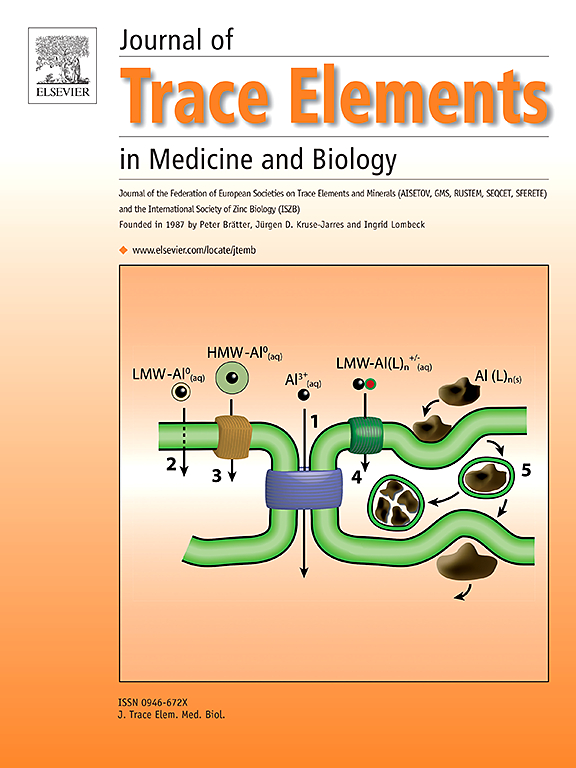Exposure assessments of cadmium and lead with age-related eye disease: A systematic review and meta-analysis
IF 3.6
3区 医学
Q2 BIOCHEMISTRY & MOLECULAR BIOLOGY
Journal of Trace Elements in Medicine and Biology
Pub Date : 2025-03-16
DOI:10.1016/j.jtemb.2025.127631
引用次数: 0
Abstract
Background
Age-related eye diseases, such as macular degeneration, cataracts, and glaucoma, are significant causes of vision loss in older adults. Emerging evidence suggests that environmental exposure to heavy metals, particularly Cadmium and lead, may play an essential role in the onset and progression of these conditions.
Methods
This systematic review and meta-analysis aimed to evaluate the association between Cadmium and lead exposure and the risk of age-related eye diseases. A comprehensive literature search was conducted across multiple databases, including PubMed, Embase, Scopus, and Web of Science, covering studies published up to July 2024. The review included observational studies on the relationship between Cadmium or lead exposure and specific eye conditions. Data extraction and quality assessment were performed independently by two reviewers. The meta-analysis utilized a random effects model to analyze cadmium and lead levels in patient and control groups, with subgroup analyses based on the type of eye disease and study design.
Results
The results revealed a significant association between cadmium exposure and an increased risk of eye diseases, particularly cataracts and glaucoma. Lead exposure was also linked to a higher risk of cataracts and macular degeneration. The study found substantial heterogeneity among the included studies, highlighting the variability in exposure assessment and population characteristics.
Conclusions
Despite these variations, the findings underscore the importance of addressing environmental exposures to toxic metals as potential risk factors for age-related eye diseases. Further research is needed to clarify the underlying mechanisms and to develop targeted interventions for reducing these risks.
镉和铅与年龄相关性眼病的暴露评估:一项系统综述和荟萃分析
背景:与年龄相关的眼病,如黄斑变性、白内障和青光眼,是老年人视力丧失的重要原因。新出现的证据表明,环境暴露于重金属,特别是镉和铅,可能在这些疾病的发生和发展中发挥重要作用。方法本系统综述和荟萃分析旨在评估镉和铅暴露与年龄相关性眼病风险之间的关系。在PubMed、Embase、Scopus和Web of Science等多个数据库中进行了全面的文献检索,涵盖了截至2024年7月发表的研究。该综述包括镉或铅暴露与特定眼病之间关系的观察性研究。数据提取和质量评估由两名审稿人独立完成。荟萃分析采用随机效应模型分析患者和对照组的镉和铅水平,并根据眼病类型和研究设计进行亚组分析。结果镉暴露与眼部疾病,特别是白内障和青光眼风险增加之间存在显著关联。铅暴露也与白内障和黄斑变性的高风险有关。该研究发现纳入的研究存在很大的异质性,突出了暴露评估和人群特征的可变性。结论:尽管存在这些差异,但研究结果强调了将环境暴露于有毒金属作为与年龄相关的眼病的潜在风险因素的重要性。需要进一步的研究来澄清潜在的机制,并制定有针对性的干预措施来减少这些风险。
本文章由计算机程序翻译,如有差异,请以英文原文为准。
求助全文
约1分钟内获得全文
求助全文
来源期刊
CiteScore
6.60
自引率
2.90%
发文量
202
审稿时长
85 days
期刊介绍:
The journal provides the reader with a thorough description of theoretical and applied aspects of trace elements in medicine and biology and is devoted to the advancement of scientific knowledge about trace elements and trace element species. Trace elements play essential roles in the maintenance of physiological processes. During the last decades there has been a great deal of scientific investigation about the function and binding of trace elements. The Journal of Trace Elements in Medicine and Biology focuses on the description and dissemination of scientific results concerning the role of trace elements with respect to their mode of action in health and disease and nutritional importance. Progress in the knowledge of the biological role of trace elements depends, however, on advances in trace elements chemistry. Thus the Journal of Trace Elements in Medicine and Biology will include only those papers that base their results on proven analytical methods.
Also, we only publish those articles in which the quality assurance regarding the execution of experiments and achievement of results is guaranteed.

 求助内容:
求助内容: 应助结果提醒方式:
应助结果提醒方式:


